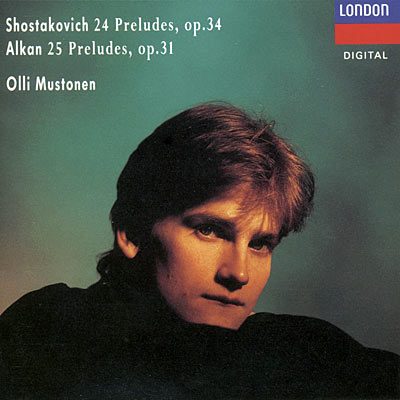Alkan/Shostakovich Preludes
View record and artist detailsRecord and Artist Details
Composer or Director: Dmitri Shostakovich, (Charles-)Valentin Alkan
Label: Decca
Magazine Review Date: 10/1991
Media Format: CD or Download
Media Runtime: 76
Mastering:
DDD
Catalogue Number: 433 055-2DH

Tracks:
| Composition | Artist Credit |
|---|---|
| (24) Preludes |
Dmitri Shostakovich, Composer
Dmitri Shostakovich, Composer Olli Mustonen, Piano |
| (25) Préludes |
(Charles-)Valentin Alkan, Composer
(Charles-)Valentin Alkan, Composer Olli Mustonen, Piano |
Author: Stephen Johnson
Vladimir Viardo's 24 Preludes has its nice touches here and there, and technically his grip is firm. It's by no means unimaginative playing, and exaggerations like the huge allargando at the climax of No. 6 are fortunately rare. The piano isn't perfectly in tune, but it's quite tolerable. In the absence of serious competition this version would have made a safe, if hardly five-star recommendation.
However, the competition is very serious indeed; in fact in both the Shostakovich and the Alkan, Olli Mustonen's playing is, simply, phenomenal. Viardo's racing semiquavers in No. 5 of the Shostakovich may be smoother, but Mustonen gives us something altogether more alive—a breathtaking cascade of notes running smack into a wonderfully improbable perfect cadence. Viardo makes effective contrast between the light moderato of No. 13 and the dark adagio of its successor; Mustonen makes this a demonstration of how Chaplinesque humour can suddenly twist into something very dark indeed. While Viardo takes the Allegretto poco moderato of No. 21 at face value, Mustonen notes the marking of five crotchets=52 and gives an unforgettable impression of a tiny music-box ballerina going quietly berserk.
The contrast is even stronger in the couplings: Viardo does nothing really exceptionable in the Shostakovich Second Sonata, but there isn't a great deal of wit, fantasy or underlying pathos. There's too little differentiation in the first movement's running quavers, and in the central Largo he's often simply too loud (only in three bars does this movement rise above piano—and, again, there's a recurring problem with tuning). Turning to Mustonen's Alkan—well, at last I can see what all the fuss is about: this elusive, quirky music suddenly seems self-explanatory. A few questions linger: is the cloudy, long-sustained pedal effect in No. 13 really what Alkan was looking for? Mustonen doesn't quite convince me here. But the differentiation of bright high melody and low, treacly left-hand chords in No. 8 is a brilliantly unsettling realization of Alkan's title, Chanson de la folle au bord de la mer. Similar insights abound, and the recording captures it all with great clarity and immediacy. The extreme heights of the piano can be a shade over-bright even in relatively quiet passages, but that's a very small price for such a genuinely illuminating experience.'
However, the competition is very serious indeed; in fact in both the Shostakovich and the Alkan, Olli Mustonen's playing is, simply, phenomenal. Viardo's racing semiquavers in No. 5 of the Shostakovich may be smoother, but Mustonen gives us something altogether more alive—a breathtaking cascade of notes running smack into a wonderfully improbable perfect cadence. Viardo makes effective contrast between the light moderato of No. 13 and the dark adagio of its successor; Mustonen makes this a demonstration of how Chaplinesque humour can suddenly twist into something very dark indeed. While Viardo takes the Allegretto poco moderato of No. 21 at face value, Mustonen notes the marking of five crotchets=52 and gives an unforgettable impression of a tiny music-box ballerina going quietly berserk.
The contrast is even stronger in the couplings: Viardo does nothing really exceptionable in the Shostakovich Second Sonata, but there isn't a great deal of wit, fantasy or underlying pathos. There's too little differentiation in the first movement's running quavers, and in the central Largo he's often simply too loud (only in three bars does this movement rise above piano—and, again, there's a recurring problem with tuning). Turning to Mustonen's Alkan—well, at last I can see what all the fuss is about: this elusive, quirky music suddenly seems self-explanatory. A few questions linger: is the cloudy, long-sustained pedal effect in No. 13 really what Alkan was looking for? Mustonen doesn't quite convince me here. But the differentiation of bright high melody and low, treacly left-hand chords in No. 8 is a brilliantly unsettling realization of Alkan's title, Chanson de la folle au bord de la mer. Similar insights abound, and the recording captures it all with great clarity and immediacy. The extreme heights of the piano can be a shade over-bright even in relatively quiet passages, but that's a very small price for such a genuinely illuminating experience.'
Discover the world's largest classical music catalogue with Presto Music.

Gramophone Digital Club
- Digital Edition
- Digital Archive
- Reviews Database
- Full website access
From £8.75 / month
Subscribe
Gramophone Full Club
- Print Edition
- Digital Edition
- Digital Archive
- Reviews Database
- Full website access
From £11.00 / month
Subscribe
If you are a library, university or other organisation that would be interested in an institutional subscription to Gramophone please click here for further information.




